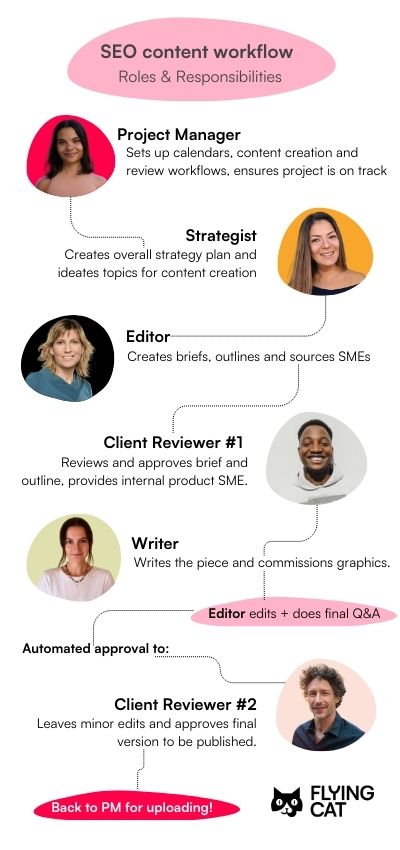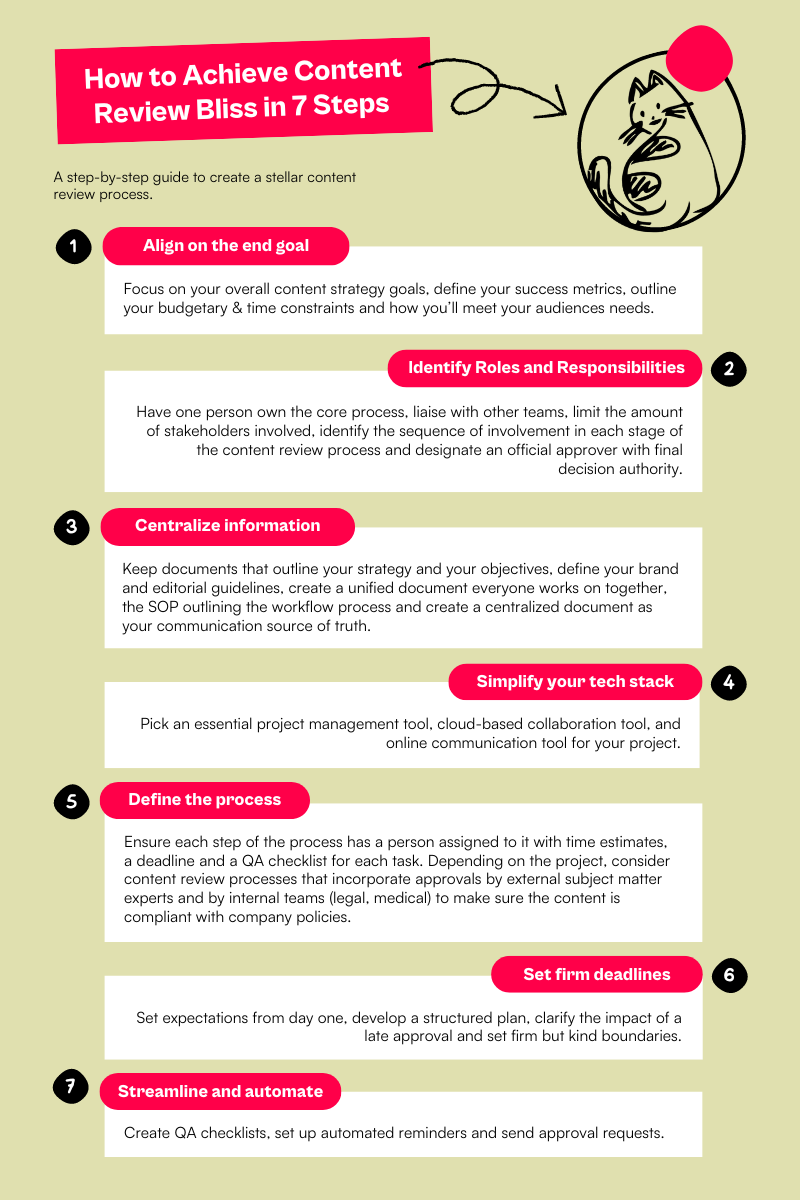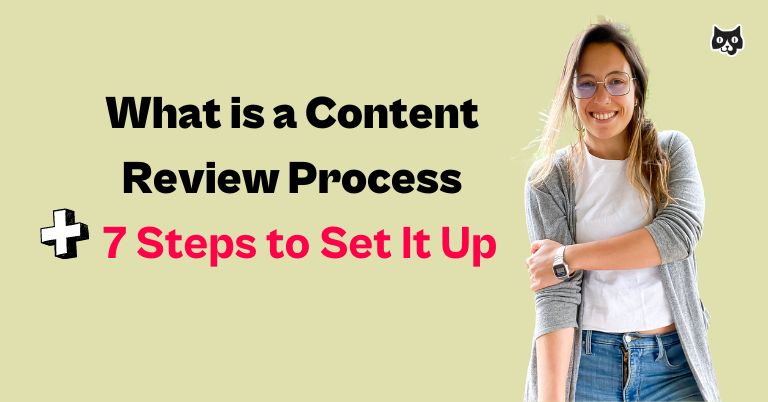Picture this: you’re knee-deep in content creation, juggling feedback from every direction, trying to hit deadlines that seem to move faster than a TikTok trend. Sound familiar?
As a seasoned marketing project manager, I get it. Those conflicting revisions, elusive approvals, and the constant ticking of a clock – it’s a wild ride.
So to help you out, in this guide, I am:
- Diving into the challenges that marketers, agencies, and PMs face daily in the content review process.
- Providing a detailed step-by-step walkthrough to help you up your content review game.
Ready to say goodbye to chaos in the content review stage? Read on!
What is a Content Review Process?
A content review process is a structured method for garnerning feedback on content and gaining approval from multiple stakeholders to ensure high-quality, on-target content that aligns with your organization’s strategic guidelines.
Think of it as a fast, consistent and streamlined way of getting a thumbs-up from your team before sharing your content with the world.
The Before: Challenges in Content Review
Now, if you’re here, I suspect your content review process isn’t fast, consistent or streamlined, but rather looks more like:
- You’re getting delayed feedback that slows down your project timelines.
- Style inconsistencies and bottlenecks in the approval process from conflicting comments.
- You’re confused because you have multiple versions of the copy in a bunch of different folders because there isn’t a clear system in place.
- Tracking comments and sign-offs have become an administrative nightmare.
- You’re stuck in endless review rounds, creating scope creep and a Frankenstein-like perpetual draft that never moves to the next stage of the content workflow.
Trust me, I get it. Content reviews are one of the hardest things to get right in a content workflow, particularly because they usually involve multiple people.
And people aren’t only busy, they also have different ways of operating and varying opinions on what’s good and what’s not.
That’s why the key to a good content review is process. Without one, you and your team will always find yourself in this kafkaesque scenario.
And your content? Forever trapped in draft limbo, never to see the light of day (or the last rays of sunshine at the end of a very long process).


Content Marketing’s Institute report revealed that 44% of marketers are challenged with workflow issues in the content approval process.
In my years as PM, I’ve seen my fair share of good content fall behind on deadlines, only to be published after being butchered by dozens of people into an incoherent stretch of nonsensical paragraphs.
At that point, the content is not only disconnected from its original intention, style and audience, but also probably outdated and getting very little traction and results.
What’s worse is that everyone in the process ends up tired and frustrated without anything they can publish with pride and an urge to share.
Truly a content nightmare.
The After: A Streamlined Content Review Process
Now, let’s move from content bureaucracy to PM paradise (my kind of place), where content review processes are:
- fast and efficient
- quality-focused
- centralized
- clear to all key stakeholders
- consistent with your brand and strategy
- within time and budget
- automated as much as possible
Yes, I am aware it’s easier said than done. But I promise you it’s possible (and I’m going to show you how you can make it happen in a second).


The Bridge: How to Achieve Content Review Bliss in 7 Steps
We’ve arrived at the end of the rainbow: The place where content review processes become efficient and effective.
Here is our proven step-by-step plan you need for your content to shine:
Step 1: Align on end goals
Start by ‘sitting down’ (yes, a Zoom meeting is good too) with all stakeholders involved in the project to ensure you’re all on the same page about the end goals of your content review process.
Keep in mind these goals will need to be:
- Aligned with overall content strategy: Are you scaling production to increase website traffic? Are you updating old pieces to fit your latest rebranding? Are you focusing on thought leadership to get backlinks?
- Reflected in your success metrics: What KPIs are you tracking to make sure content is working? Clicks? Social media followers? Conversions? Revenue?
- Within your budget and time limits: No point in establishing far-fetched, unattainable goals — make sure these are always within the limits of your project’s scope and your team’s workload.
- Tailored to meet your audience’s needs: Do not lose track of what your readers are looking for!
Though it might not seem like it at first, I promise all these factors will have a great impact on your content review process.
For example, if your goal is to be found on search engines, you probably don’t need to focus too much on every single comma in your content reviews and you can rather publish pieces fast now and optimize them later.
Or, if you’re looking to get backlinks from thoroughly-researched whitepapers, then you might want to do an extra round of fact-checking your stats at the end.
Step 2: Identify Roles and Responsibilities
Too many cooks in the kitchen spoil the broth.
That’s why my pro tips for this step are:
- Have one person own the core process: They will ensure that the end goals remain at the forefront of everyone’s minds throughout the process. This will ideally be the account, project, or content manager.
- Give the other teams a seat at the table: Is there a medical or a legal team that needs to make sure pieces are compliant with current company policies? Ensure their goals and responsibilities are considered in the process.
- Limit the number of stakeholders involved: Even though some team members’ participation will be essential in the content review process, be wary of involving way too many people as it might make the process too complex and long-winded.
- Identify the order in which they will step into the content review process: Who will come first, second, third? Agree on an established order depending on the type and intent of the content.
- Establish one final ‘official approver’: Avoid confusion on whether the piece of content is ready or not by assigning one person to do the final sign-off before the piece is sent off to be uploaded and published.
This is certainly one of the most challenging parts of setting up a content approval review process since you will be dealing with different points of view, preferences and priorities.
In my experience, listening attentively, negotiating and overcommunicating will be your superpowers when it comes to coming out of this stage unscathed.
And when things get off track, my advice is to remind everyone of what the end goal we are all trying to achieve here is: that will help you realign your efforts.
In our usual SEO content workflow here at Flying Cat, here is what the usual list of roles and responsibilities look like:


Step 3: Centralize information
I can tell you right now the easiest way to lose track of things in a content review process is having information flying all over the place.
That is why one central hub for all resources, communications and workflows is so important.
Here are the key elements you need to keep centralized:
- Strategy and objectives: all stakeholders should have access to the overall, big-picture plan and the goals you set up in step 1 to guarantee full alignment.
- Brand/Editorial Guidelines: whether it is a tone of voice guide for content creators, brand colors for graphics or a scripting manual for videos, this is one of the main resources that everyone needs access to (and that needs to be kept updated with any new change).
- Work files: the actual document or file where the team is doing the work should be the same one at all times. With the immense amount of options for cloud-based collaboration tools today (see my fave picks in step 4), gone are the days of multiple document versions scattered all around.
- Workflows and processes: both the actual workflow (the work being done) and the process (how to do the work) need to be accessible to everyone involved in the project. This is best done through an all-encompassing project management tool (see step 4).
- Communications: your team needs one single source of truth where all discussions around the project are kept. This will save you from communication silos and avoid misalignments.
| 💡Pro tip: any time a new person joins the project, make sure you onboard them onto the process and give them access to all these tools and resources. |
Step 4: Simplify your tech stack
Back in my early days of project management, I used to send one Word doc to stakeholder 1, and they’d reply with a V2 of the file. Then, I’d have to forward that to stakeholder 2, who’d send me their feedback over a separate email and I’d have to collate the whole thing in a new file.
Repeat that 10 times and you’ve got yourself a content management nightmare.
Luckily, these days we have hundreds of collaboration tools that have made these processes so much easier.
After many years of testing dozens of them, I am a firm believer in a ‘less is more’ approach these days to help me keep things simple and streamlined.
That is why I think you only need 3 core software tools for an efficient content review process:
- Cloud-based collaboration tool: as I said in step 3, you need a central hub to save all your resources and docs. This is where you’ll keep your strategy doc, project goals, brand guidelines and work documents.
- My pick: In my opinion, nothing beats Google Drive. Google Docs also makes it really simple to see version history and keep all iterations within one single file.
- Project management tool: this is where you will design your content creation process (step 5) and the place where your content team will have set due dates and tasks to complete their part of the work.
- My pick: My fave here is ClickUp, but Productive, Asana and Trello are also close runner-ups.
- Online communication tool: even though email is still used in many organizations, I much prefer an IM tool that can make conversations much more dynamic and accelerate decision-making.
- My pick: Slack is hands-down my preferred choice on this front.
| 🎁Bonus: As an extra, I’d suggest adding an automation tool (I personally love Zapier) to connect each of these tools to each other and automate most of your workflow (see step 7). |
Step 5: Define the process
OK, so now you’ve got your goals, documents and tools all set up. You just need to define what the content review process will look like then.
A standard content review and approval process will usually look like this:
- Person 1 submits the first draft of the content.
- Reviewers 1/2/3 give their feedback and either request changes or approve the content.
- Person 1 makes any requested changes and submits an updated version.
- This process repeats until all stakeholders have reviewed the content.
Keep in mind this process is not always at the final draft stage: you could have more than one content review process at different stages in production.
For example, at Flying Cat we have two core ones:
- At the outline stage, for clients to submit big-picture notes on what they want to see included in the content;
- At the final draft stage, for clients to have one last look at the content created and leave minor comments.
| 💡Pro tip: A content review process hardly ever stays the same over time. Make sure you keep your workflow flexible and make changes as you find ways to simplify it. |
Anything from 1 to 3 people in the client’s marketing team will usually review the content (usually the Content Manager and the Marketing Manager) but as explained in step 2, we always establish who will be doing the final approval of the version to be published.
Depending on the project, we also have content review processes to incorporate:
- Approvals by external subject matter experts that have contributed to the piece.
- Approvals by internal teams (legal, medical) to make sure the content is compliant with company policies.
What I mean by these examples is that by designing a clear pathway of what approvals you need and at which stage, you will be able to ideate your own personalized content review workflow.
Once you have that, you can go ahead and set it up in your project management tool. This is what one of our workflows looks like in ClickUp, for example:


Each step of the process has:
- A single person assigned to it, which allows for ownership and accountability,
- A time estimate, to make sure the project is within scope and budget,
- A deadline (see step 6) to ensure work is delivered on time,
- A checklist (see step 7) as a QA step for all tasks.
| 👋 Say Goodbye to Content Review Chaos! Streamline approvals, eliminate bottlenecks, and deliver high-quality content on time, every time. Check out our SOP toolkits |
Step 6: Set firm deadlines
The dreaded deadline.
Any person setting up a content review process will surely have struggled to set them up and, most likely, make people follow them (a.k.a. follow up a dozen times).
Here are my pro tips on how to make sure deadlines are on time in a content review process:
- Set expectations from day one: Overcommunication is your best tactic here once again. Educate people on what each step involves and when they need to do their content review.
- Have a laid-out plan: Try to design an approval calendar as much in advance as possible. This will give you enough room to pivot if things change at the last minute (people off sick, shifts in priorities, etc).
- Clarify what the impact of late approvals is: Be absolutely transparent as to what a missed due date implies. Most likely, it will be that it delays publishing, which in turn delays results being achieved. This will put things into perspective for reviewers.
- Be firm: Of course there is always room for last-minute emergencies, but otherwise make sure you are resolute in your approach to deadlines to make sure the project stays on track.
| 🎁Bonus: Struggling to communicate deadlines clearly and firmly? Steal our tested and proven message template to get approvals done on time! Hey [Client name], Please see here [content piece X]. Here is an accompanying video with instructions on how to conduct your review. Please watch the video and read the document in detail. Then, leave your reviews using tracked changes and comments so the Editor can easily see what you’ve changed. For anything you are unsure of or would like to discuss further, please let us know over Slack so we can arrange a quick call to realign. Please note we need the document to be reviewed within the next 48 hours to maintain production on track. Once you review the document, please tag the PM in Slack to let them know you’ve left comments inside the doc. We will then get back to you with a final version within 24 hours. Please keep in mind that once you approve the final version, we will go ahead and upload and schedule it for publishing per our content calendar, and we can’t make any further changes at that point. We ask that you follow the process and respect the deadlines to ensure a quick turnaround and impactful results.Let me know if you have any questions. Thanks, |
Step 7: Streamline and automate
Another major thing that has shifted from my days as a junior PM to today is how involved the workflow manager needs to be in a content review process.
See, before, you wouldn’t have gone past stage 1 of a content production workflow without human involvement. These days, we luckily have many AI and automation tools that can help us simplify it and save us tons of time.
Here are my top 3 favorite ways to streamline your review workflow with automations:
- Create QA checklists: These should provide guidance for reviewers, ensuring that all essential aspects (i.e. grammatical errors, brand alignment and content best practices) are thoroughly evaluated.
- Set up automated reminders: Eliminate the need for manual follow-ups by leveraging automated reminders that prompt stakeholders to complete their assigned tasks.
- Send automatic approval requests: These requests ensure clear communication of deadlines and enable timely decision-making, keeping the project on track.
Embracing automation at Flying Cat has truly transformed our content review game, saving us valuable time and increasing overall efficiency (an average of 30% in PM time savings in the past year!).


Conclusion
To ensure high-quality content that aligns with your goals, implementing a well-structured content review process is crucial.
By aligning with your strategy, involving stakeholders, centralizing information, simplifying your tech stack, setting clear deadlines, and leveraging automation, you can streamline collaboration and save precious time.
With a streamlined content review process in place, I promise you’ll experience smoother collaboration, faster approvals, and ultimately, content that delivers results.
Happy reviewing!
